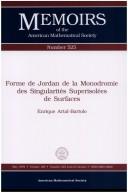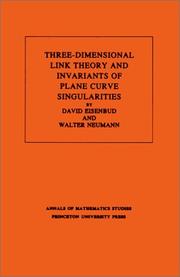| Listing 1 - 5 of 5 |
Sort by
|

ISSN: 00659266 ISBN: 0821825879 Year: 1994 Publisher: Providence (R.I.): American Mathematical Society
Abstract | Keywords | Export | Availability | Bookmark
 Loading...
Loading...Choose an application
- Reference Manager
- EndNote
- RefWorks (Direct export to RefWorks)
Algebraic topology --- Hodge theory --- Jordan matrix --- Singularities (Mathematics) --- Hodge, Théorie de --- Singularités (mathématiques) --- Geometry, Algebraic --- Form, Jordan --- Form, Jordan normal --- Jordan form --- Jordan normal form --- Matrix, Jordan --- Matrices --- Complex manifolds --- Differentiable manifolds --- Homology theory --- Hodge, Théorie de.
Book
ISBN: 3039217313 3039217305 Year: 2019 Publisher: MDPI - Multidisciplinary Digital Publishing Institute
Abstract | Keywords | Export | Availability | Bookmark
 Loading...
Loading...Choose an application
- Reference Manager
- EndNote
- RefWorks (Direct export to RefWorks)
Although scientific computing is very often associated with numeric computations, the use of computer algebra methods in scientific computing has obtained considerable attention in the last two decades. Computer algebra methods are especially suitable for parametric analysis of the key properties of systems arising in scientific computing. The expression-based computational answers generally provided by these methods are very appealing as they directly relate properties to parameters and speed up testing and tuning of mathematical models through all their possible behaviors. This book contains 8 original research articles dealing with a broad range of topics, ranging from algorithms, data structures, and implementation techniques for high-performance sparse multivariate polynomial arithmetic over the integers and rational numbers over methods for certifying the isolated zeros of polynomial systems to computer algebra problems in quantum computing.
superposition --- SU(2) --- pseudo-remainder --- interval methods --- sparse polynomials --- element order --- Henneberg-type minimal surface --- timelike axis --- combinatorial decompositions --- sparse data structures --- mutually unbiased bases --- invariant surfaces --- projective special unitary group --- Minkowski 4-space --- free resolutions --- Dini-type helicoidal hypersurface --- linearity --- integrability --- Galois rings --- minimum point --- entanglement --- degree --- pseudo-division --- computational algebra --- polynomial arithmetic --- projective special linear group --- normal form --- Galois fields --- Gauss map --- implicit equation --- number of elements of the same order --- Weierstrass representation --- Lotka–Volterra system --- isolated zeros --- polynomial modules --- over-determined polynomial system --- simple Kn-group --- sum of squares --- four-dimensional space
Book
ISBN: 1400847184 1299051456 1400846102 9781400846108 9780691157122 069115712X 9780691157153 0691157154 9781299051454 Year: 2013 Publisher: Princeton, NJ
Abstract | Keywords | Export | Availability | Bookmark
 Loading...
Loading...Choose an application
- Reference Manager
- EndNote
- RefWorks (Direct export to RefWorks)
This book provides the mathematical foundations for the analysis of a class of degenerate elliptic operators defined on manifolds with corners, which arise in a variety of applications such as population genetics, mathematical finance, and economics. The results discussed in this book prove the uniqueness of the solution to the Martingale problem and therefore the existence of the associated Markov process. Charles Epstein and Rafe Mazzeo use an "integral kernel method" to develop mathematical foundations for the study of such degenerate elliptic operators and the stochastic processes they define. The precise nature of the degeneracies of the principal symbol for these operators leads to solutions of the parabolic and elliptic problems that display novel regularity properties. Dually, the adjoint operator allows for rather dramatic singularities, such as measures supported on high co-dimensional strata of the boundary. Epstein and Mazzeo establish the uniqueness, existence, and sharp regularity properties for solutions to the homogeneous and inhomogeneous heat equations, as well as a complete analysis of the resolvent operator acting on Hölder spaces. They show that the semigroups defined by these operators have holomorphic extensions to the right half-plane. Epstein and Mazzeo also demonstrate precise asymptotic results for the long-time behavior of solutions to both the forward and backward Kolmogorov equations.
Elliptic operators. --- Markov processes. --- Population biology --- Analysis, Markov --- Chains, Markov --- Markoff processes --- Markov analysis --- Markov chains --- Markov models --- Models, Markov --- Processes, Markov --- Stochastic processes --- Differential operators, Elliptic --- Operators, Elliptic --- Partial differential operators --- Mathematical models. --- 1-dimensional integral. --- Euclidean model problem. --- Euclidean space. --- Hlder space. --- Hopf boundary point. --- Kimura diffusion equation. --- Kimura diffusion operator. --- Laplace transform. --- Schauder estimate. --- WrightІisher geometry. --- adjoint operator. --- backward Kolmogorov equation. --- boundary behavior. --- degenerate elliptic operator. --- doubling. --- elliptic Kimura operator. --- elliptic equation. --- forward Kolmogorov equation. --- function space. --- general model problem. --- generalized Kimura diffusion. --- heat equation. --- heat kernel. --- higher dimensional corner. --- higher regularity. --- holomorphic semi-group. --- homogeneous Cauchy problem. --- hybrid space. --- hypersurface boundary. --- induction hypothesis. --- induction. --- inhomogeneous problem. --- irregular solution. --- long time asymptotics. --- long-time behavior. --- manifold with corners. --- martingale problem. --- mathematical finance. --- model problem. --- normal form. --- normal vector. --- null-space. --- off-diagonal behavior. --- open orthant. --- parabolic equation. --- perturbation theory. --- polyhedron. --- population genetics. --- probability theory. --- regularity. --- resolvent operator. --- semi-group. --- solution operator. --- uniqueness.

ISBN: 0691083819 0691083800 1400881927 9780691083810 9780691083803 Year: 1985 Volume: 110 Publisher: Princeton Princeton University Press
Abstract | Keywords | Export | Availability | Bookmark
 Loading...
Loading...Choose an application
- Reference Manager
- EndNote
- RefWorks (Direct export to RefWorks)
This book gives a new foundation for the theory of links in 3-space modeled on the modern developmentby Jaco, Shalen, Johannson, Thurston et al. of the theory of 3-manifolds. The basic construction is a method of obtaining any link by "splicing" links of the simplest kinds, namely those whose exteriors are Seifert fibered or hyperbolic. This approach to link theory is particularly attractive since most invariants of links are additive under splicing.Specially distinguished from this viewpoint is the class of links, none of whose splice components is hyperbolic. It includes all links constructed by cabling and connected sums, in particular all links of singularities of complex plane curves. One of the main contributions of this monograph is the calculation of invariants of these classes of links, such as the Alexander polynomials, monodromy, and Seifert forms.
Algebraic geometry --- Differential geometry. Global analysis --- Link theory. --- Curves, Plane. --- SINGULARITIES (Mathematics) --- Curves, Plane --- Invariants --- Link theory --- Singularities (Mathematics) --- Geometry, Algebraic --- Low-dimensional topology --- Piecewise linear topology --- Higher plane curves --- Plane curves --- Invariants. --- 3-sphere. --- Alexander Grothendieck. --- Alexander polynomial. --- Algebraic curve. --- Algebraic equation. --- Algebraic geometry. --- Algebraic surface. --- Algorithm. --- Ambient space. --- Analytic function. --- Approximation. --- Big O notation. --- Call graph. --- Cartesian coordinate system. --- Characteristic polynomial. --- Closed-form expression. --- Cohomology. --- Computation. --- Conjecture. --- Connected sum. --- Contradiction. --- Coprime integers. --- Corollary. --- Curve. --- Cyclic group. --- Determinant. --- Diagram (category theory). --- Diffeomorphism. --- Dimension. --- Disjoint union. --- Eigenvalues and eigenvectors. --- Equation. --- Equivalence class. --- Euler number. --- Existential quantification. --- Exterior (topology). --- Fiber bundle. --- Fibration. --- Foliation. --- Fundamental group. --- Geometry. --- Graph (discrete mathematics). --- Ground field. --- Homeomorphism. --- Homology sphere. --- Identity matrix. --- Integer matrix. --- Intersection form (4-manifold). --- Isolated point. --- Isolated singularity. --- Jordan normal form. --- Knot theory. --- Mathematical induction. --- Monodromy matrix. --- Monodromy. --- N-sphere. --- Natural transformation. --- Newton polygon. --- Newton's method. --- Normal (geometry). --- Notation. --- Pairwise. --- Parametrization. --- Plane curve. --- Polynomial. --- Power series. --- Projective plane. --- Puiseux series. --- Quantity. --- Rational function. --- Resolution of singularities. --- Riemann sphere. --- Riemann surface. --- Root of unity. --- Scientific notation. --- Seifert surface. --- Set (mathematics). --- Sign (mathematics). --- Solid torus. --- Special case. --- Stereographic projection. --- Submanifold. --- Summation. --- Theorem. --- Three-dimensional space (mathematics). --- Topology. --- Torus knot. --- Torus. --- Tubular neighborhood. --- Unit circle. --- Unit vector. --- Unknot. --- Variable (mathematics).
Book
ISBN: 1400882591 Year: 2016 Publisher: Princeton, NJ : Princeton University Press,
Abstract | Keywords | Export | Availability | Bookmark
 Loading...
Loading...Choose an application
- Reference Manager
- EndNote
- RefWorks (Direct export to RefWorks)
Riemann introduced the concept of a "local system" on P1-{a finite set of points} nearly 140 years ago. His idea was to study nth order linear differential equations by studying the rank n local systems (of local holomorphic solutions) to which they gave rise. His first application was to study the classical Gauss hypergeometric function, which he did by studying rank-two local systems on P1- {0,1,infinity}. His investigation was successful, largely because any such (irreducible) local system is rigid in the sense that it is globally determined as soon as one knows separately each of its local monodromies. It became clear that luck played a role in Riemann's success: most local systems are not rigid. Yet many classical functions are solutions of differential equations whose local systems are rigid, including both of the standard nth order generalizations of the hypergeometric function, n F n-1's, and the Pochhammer hypergeometric functions. This book is devoted to constructing all (irreducible) rigid local systems on P1-{a finite set of points} and recognizing which collections of independently given local monodromies arise as the local monodromies of irreducible rigid local systems. Although the problems addressed here go back to Riemann, and seem to be problems in complex analysis, their solutions depend essentially on a great deal of very recent arithmetic algebraic geometry, including Grothendieck's etale cohomology theory, Deligne's proof of his far-reaching generalization of the original Weil Conjectures, the theory of perverse sheaves, and Laumon's work on the l-adic Fourier Transform.
Differential equations --- Hypergeometric functions. --- Sheaf theory. --- Numerical solutions. --- Additive group. --- Alexander Grothendieck. --- Algebraic closure. --- Algebraic differential equation. --- Algebraically closed field. --- Algorithm. --- Analytic continuation. --- Automorphism. --- Axiom of choice. --- Bernhard Riemann. --- Big O notation. --- Calculation. --- Carlos Simpson. --- Coefficient. --- Cohomology. --- Commutator. --- Compactification (mathematics). --- Comparison theorem. --- Complex analytic space. --- Complex conjugate. --- Complex manifold. --- Conjecture. --- Conjugacy class. --- Convolution. --- Corollary. --- Cube root. --- Cusp form. --- De Rham cohomology. --- Differential equation. --- Dimension. --- Dimensional analysis. --- Discrete valuation ring. --- Disjoint union. --- Divisor. --- Duality (mathematics). --- Eigenfunction. --- Eigenvalues and eigenvectors. --- Elliptic curve. --- Equation. --- Equivalence of categories. --- Exact sequence. --- Existential quantification. --- Finite field. --- Finite set. --- Fourier transform. --- Functor. --- Fundamental group. --- Generic point. --- Ground field. --- Hodge structure. --- Hypergeometric function. --- Integer. --- Invertible matrix. --- Isomorphism class. --- Jordan normal form. --- Level of measurement. --- Linear differential equation. --- Local system. --- Mathematical induction. --- Mathematics. --- Matrix (mathematics). --- Monodromy. --- Monomial. --- Morphism. --- Natural filtration. --- Parameter. --- Parity (mathematics). --- Perfect field. --- Perverse sheaf. --- Polynomial. --- Prime number. --- Projective representation. --- Projective space. --- Pullback (category theory). --- Pullback. --- Rational function. --- Regular singular point. --- Relative dimension. --- Residue field. --- Ring of integers. --- Root of unity. --- Sequence. --- Sesquilinear form. --- Set (mathematics). --- Sheaf (mathematics). --- Six operations. --- Special case. --- Subgroup. --- Subobject. --- Subring. --- Suggestion. --- Summation. --- Tensor product. --- Theorem. --- Theory. --- Topology. --- Triangular matrix. --- Trivial representation. --- Vector space. --- Zariski topology.
| Listing 1 - 5 of 5 |
Sort by
|

 Search
Search Feedback
Feedback About UniCat
About UniCat  Help
Help News
News